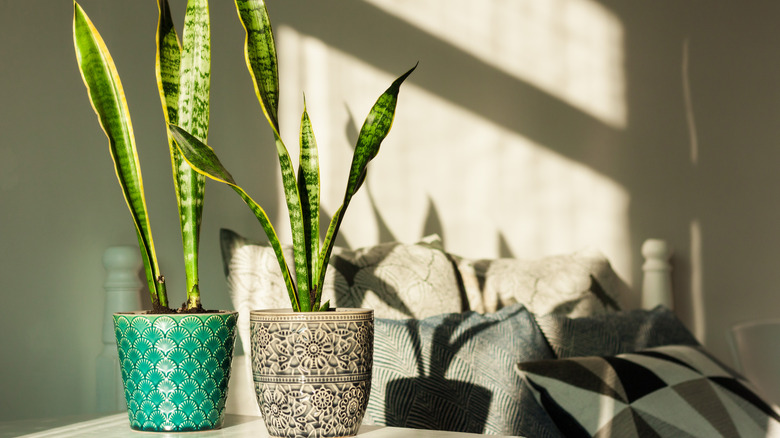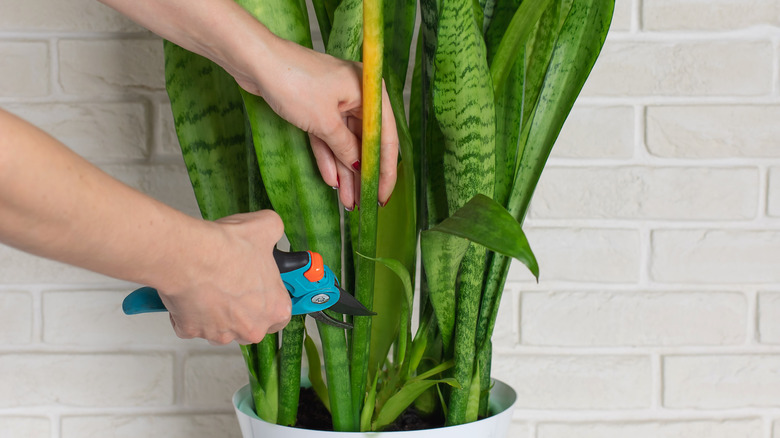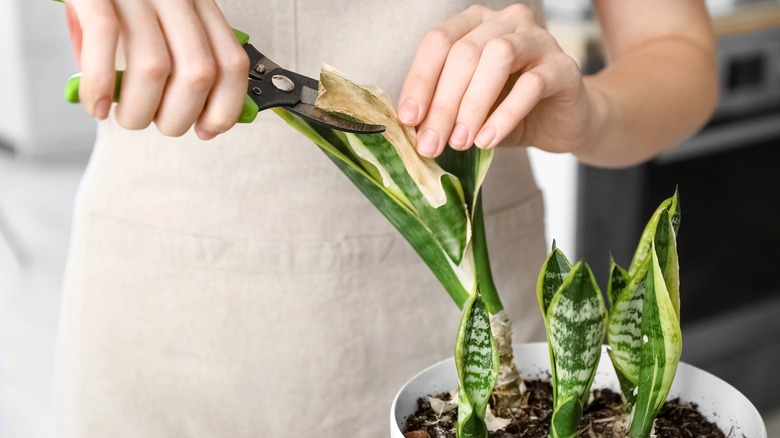Keep Your Snake Plant Healthy With These Helpful Pruning Tricks
Snake plants in the home (Dracaena trifasciata) are named for their elegant yellow and green leaves that have a pattern resembling snakeskin. These houseplants are linked to health benefits like air purification, and feng shui experts believe they draw positive energy as well. While these plants are relatively easy to care for, as with any plant, pruning is an important part of their regular maintenance. Knowing how, when, and why to prune is key to giving your greenery a long and healthy life.
Although they grow very slowly, snake plants can eventually lose their shape and become too large for their current space, so occasional pruning will help them look their best. If any leaves become damaged or diseased, you'll need to trim the affected areas. You may also decide to propagate your snake plant into multiple plants. This is easy to do by removing a few leaves, which will each grow into a new plant that's identical to the first.
At the same time, your snake plant needs its leaves to photosynthesize, and removing too many can impact its growth. Furthermore, cutting off part of a leaf creates a wound in the plant, which can be more prone to disease. Before you get out those pruning shears, make sure you understand how to trim your snake plant safely. When done right, pruning will make your plant healthier and encourage new growth.
How to prune your snake plant
If you're pruning your snake plant for aesthetic purposes or as part of regular maintenance, it's important to prune it at the right time. Avoid removing leaves during winter, when the plant is dormant — wait until spring when it resumes active growth. Then you can remove any unkempt leaves, shorten overgrown leaves, and reshape the plant as a whole. However, be careful not to get carried away. It's a good rule of thumb to only cut off less than a quarter of the plant's foliage.
If you're planning to propagate your snake plant or cut off severely-damaged leaves, remove them at the base, near the soil. If you're pruning slightly-damaged leaves or for aesthetics, you may want to remove only part of a leaf. Cutting it straight across will make it stand out from the rest — instead, make two angled cuts so the leaf ends in a point that looks like the rest of the plant.
When trimming a snake plant's leaves, you don't necessarily need fancy pruning shears, as plain old scissors will work fine. The sharpness and cleanliness of the tool you use is more important than the type. Keeping the blades sharp will ensure a clean cut and prevent further damage to the plant. Always wipe the blades with rubbing alcohol before you start pruning and when moving from one plant to the next to keep your plants safe from disease. You can also help protect your plant from disease after trimming by covering the cut in cinnamon.
Getting to the root of the problem
Snake plants are often recommended for budding gardeners (pun intended) because they're one of the easiest houseplants to maintain. However, without the right care, they can still be prone to serious issues. If your snake plant's leaves are showing signs of damage or disease, don't just prune away the affected areas. Instead, be sure to treat the root cause of the problem as well.
Troubleshooting snake plant leaves is simple when you know what to look for. A scratch on a leaf or a piece that's broken off is probably a sign that someone (perhaps a pet) bumped into the plant. In that case, all you need to do is trim away the damage. Crispy brown or bleached white spots on leaf tips are a symptom of sunburn; trim these and move the plant out of direct sunlight.
If your snake plant's leaves are looking yellow, brown, wilted, or droopy, this may mean that you've given it too much water. For succulents (including snake plants), which thrive in dry environments, overwatering can lead to life-threatening root rot. You'll need to act fast to treat the root rot by pruning away any rotted roots and damaged leaves. You may also need to prune some healthy leaves so the smaller root system has less foliage to support while it recovers.


